You are using an out of date browser. It may not display this or other websites correctly.
You should upgrade or use an alternative browser.
You should upgrade or use an alternative browser.
The Most NOTABLE/PIONEERING Rappers of CONFIRMED AND ACTUAL Afram descent OFFICIAL list
- Thread starter IllmaticDelta
- Start date
More options
Who Replied?IllmaticDelta
Veteran
Paint It Back: The History of American Graffiti
Thanks to President Obama and the Academy Awards, Shepard Fairey and Banksy are household names today. But before mainstream media plastered their work across the world, they’d already done it for themselves, rising to the status of contemporary street art royalty: infamous and rich for making illegal and legal artwork that kids cop and celebrities and curators covet. Both artists would admit, however, that they are just part of a continuum. As Roger Gastman and Caleb Neelon, co-authors of The History of American Graffiti, assert in their introduction, “Humans write graffiti.” So true: cave paintings, petroglyphs, and pictographs begat World War II “Kilroy was here” and Bozo Texino scrawls on railcars begat disenfranchised kids “getting up” on any surface they could slick with ink and paint.
Exactly who was the first kid to spread a name or moniker across a cityscape is up for debate, but this book is as close as one will ever get to a definitive answer. A blow-by-blow, regional dissection of graffiti’s proliferation across the United States, relying on first-hand accounts, interviews, mountains of photographs, and a pinch of healthy speculation, Gastman and Neelon have connected the dots to reveal a comprehensive and important story about how doing something as simple as writing your name in a public space grew into a global movement that has left its colorful residue on all aspects of culture, from politics and media to fashion and urban planning.
Common knowledge to those in the know, but perhaps a surprise to neophytes, graffiti as we think of it today started in Philadelphia, not New York. In 1965, yearning for his grandmother’s cornbread while at reform school, Darryl Alexander McCray started writing CORNBREAD on the school’s buildings, vying for attention alongside the names of gangs. Released in 1967, CORNBREAD ran roughshod through North Philadelphia, inspiring others like COOL EARL and KOOL KLEPTO KIDD. Soon, teenagers were canvassing the city with their tags, running in crews, and keeping tabs on other crews operating in different neighborhoods (which eventually led to crews with national chapters, like TKO). KOOL KLEPTO KIDD recalls the first time he met writers from West Philadelphia, “that was really a beautiful feeling because we had been tracking each other for the longest time.”
There is an element of graffiti fueled by conflict – personal beefs, neighborhood disputes, gang rivalries – and while the book does not shy away from these realities, the dominant theme is that kids rallied around graffiti. In fact, as the authors astutely point out, they invented it: “Graffiti can claim something that no other art movement can: it was entirely created and developed by kids.” With the disillusionment fomented by a string of senseless assassinations, the Vietnam War, and Watergate, kids knew that it was up to them to stake their claim in a culture that was both indifferent and inept when it came to bettering the quality of life in the country’s urban centers.
Certainly that is what happened in New York when graffiti really took shape as the city’s finances and national reputation were in a downward spiral. As LIL SOUL 159, a Queens-based writer active in the early 1970s insists, “Any writer will tell you that graffiti tore down the racial barriers of the late 1960s and early 1970s – eradicated them! And you just didn’t see that in New York City until graffiti hit the scene. Once we smelled that ink, we were just writers.” This sense of camaraderie fueled with a dose of healthy competition spawned the highly stylized, audacious lettering that blanketed trains, buildings, billboards, and any other imaginable city substrate so as to spread a name far and wide. Writers prioritized subway lines that covered the most ground. Seeing SUPER KOOL 223 all over the 4 train, which runs between the Bronx and Brooklyn, STAY HIGH 149 decided he had to go bigger and better. This attitude, shared by most writers, resulted in tags evolving from written monikers followed by numbers usually representing streets to more ornate pieces comprising block and bubble lettering, characters, and other visual ornaments.
The same as MTA trains carried a writer’s fame across boroughs, freight trains began to crisscross the county ablaze with the work of writers no longer content to be all-city. The freights let kids who had never been out of state go all-country, spreading graffiti through the suburbs and desolate plains of middle America. While plenty of books have documented the graffiti of New York, Los Angeles, the San Francisco Bay Area, and the primary instigators of these scenes, Gastman and Neelon have dug much, much deeper, covering cities like Chicago and Washington D.C., as well as Cleveland, Pittsburgh, Boston, Nashville, Denver, Alburquerque – the list goes on. In doing so they trace graffiti’s development and make the case for it as a true American art form akin to jazz.
In the 1980s, the documentary Wild Style and the book Subway Art played major roles in establishing graffiti as a legitimate art movement; bolstered by its relationship to hip-hop, writers got their first tastes of celebrity and gallery cultures. At the same time, because of the work they did on the streets, the media clumped Keith Haring and Jean-Michel Basquiat with writers like DAZE. Neither Haring nor Basquiat considered themselves graffiti artists, but they did help usher in the era of street art. While traditional aerosol tags continued to go up all over the country, and world, new materials and methods were applied to the streets. Posters, stickers, and stencils carried messages, logos, and more formalized characters. Today graffiti and street art thrive; artists travel the world, receive commissions, sell their art for huge sums, and license their work for ads, sneakers, and video games.
But one person’s hero is another’s vandal. Street art remains illegal almost everywhere. Municipalities actively and aggressively buff people’s work. Visit a wall in some city today and it won’t look like it did back in 1979, 1985, 1999, or even 2004. The carvings and paintings of France’s Lascaux caves and the canyons of the American southwest have been preserved as vital visual records of how early humans externalized interior thoughts. But the graffiti in this book has been painted over or chipped away, though it serves as the foundation for a global art movement that is as much about claiming individuality as it is about visual aesthetics.
This is what makes The History of American Graffiti that much more impressive. Roger Gastman and Caleb Neelon have gathered the origins of a story that up until now have only existed in fragments. For graffiti fans, pieces of the puzzle will be filled in and the riot of never-before-seen imagery will guarantee that this book is always within reach. Don’t like graffiti? It matters not, as this is a worthy read if you have any interest in late twentieth century America because the world we live in would not look the same if it weren’t for bold, creative kids hell bent on making sure that their presence was recognized by a culture that easily could have forgotten them.
http://www.themillions.com/2011/04/paint-it-back-the-history-of-american-graffiti.html
.
.
.

"Cornbread"
Darryl McCray, known by his tagging name, "Cornbread", is a graffiti artist from Philadelphia, credited with being the first modern graffiti artist. McCray was born in North Philadelphia in 1953 and raised in Brewerytown, Philadelphia, a neighborhood of North Philadelphia. During the late 1960s, he and a group of friends started "tagging" Philadelphia, by writing their nicknames on walls across the city.[1] The movement spread to New York City and blossomed into the modern graffiti movement, which reached its peak in the U.S. in the late 1970s and early 1980s, and then spread to Europe. Since his tagging days, McCray has developed a close relationship with The Philadelphia Mural Arts Program. He is a public speaker and a youth advocate.
Philly has given us a lot

IllmaticDelta
Veteran
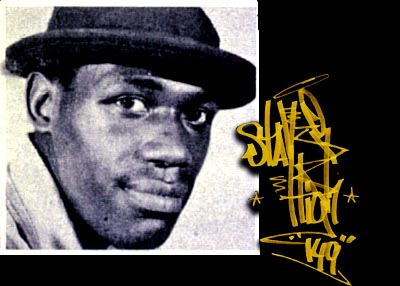


Stay High 149
Wayne Roberts (October 20, 1950 – June 11, 2012), known as Stay High 149, was an American graffiti artist.[2][3]
Roberts was born in Emporia, Virginia, moving to the Bronx, New York at age six.[1] He was called a "superstar" of the graffiti world in the late 1970s.[4] Widely considered to use one of the most famous graffiti tags in the world, his trademark includes a smoking version of the stick figure from 1960s British television program The Saint.[5]
Roberts was featured in the 2004 documentary Just to Get a Rep by Peter Gerard.
STAY HIGH 149 - Pioneer
Aliases: VOICE OF THE GHETTO
Started:Early 1970s Primary affiliations: Ex Vandals (Bronx division), U.G.A. Local origin: #
Main lines: All-city
During the early 1970s STAY HIGH 149's name adorned hundreds of New York City's subway cars, particularly on the IRT division. He is one of the most famous, influential and admired writers in the history of New York City aerosol art. Most notably admired for his unique tag. He drew a smoking joint as the cross bar for his "H". Each tag was accompanied by a stick figure from the television series The Saint. He also frequently wrote the phrase "Voice of the Ghetto". His logo/name came to define "street cool" for many subsequent generations of writers. He is one of the most frequently mentioned influences for New York City writers.



One of the most famous pieces in aerosol art to date is the STAY HIGH 149 top-to-bottom on the IRT subway; documented in Norman Mailer's 1974 book The faith of Graffiti. The painting done in 1973, was an early top-to-bottom whole car. As with most pieces of the time period, it was basically an extremely large version of his tag. His subway paintings also appeared in 1974 in a Richard Goldstein article for New York Magazine. STAY HIGH also participated in early presentations of graffiti art on canvas at Hugo Martinez's United graffiti Artists.
By 1974 STAY HIGH had pretty much retired from writing. After his retirement he was seldom seen and eventually went into total obscurity. His absence would span almost twenty years. In June of 2000 he made his first public appearance in the graffiti community at The State of the Art gallery in Brooklyn. Needless to say the many writers who met him for the first time were nothing short of awestruck. He remains an unblemished icon within the aeorsol art culture.
In the late 1960’s and early 1970’s, times were hard. New York City was constantly bankrupt and business people were burning-down slums. The mafia was flooding the country with heroin, crime rate was really exploding, and prejudice was at an all time high. Gang life, in areas where no policeman would dare to show his/her face, had become a fight for survival. Graffiti became an outlet for young people living in New York, as a way to veer from the gangs and drugs. It gave youths like, STAY HIGH, a sense of self worth.
STAY HIGH, in 1969 was a nineteen-year old youth living in a suppressed area of the Bronx. He would ride the
trains as a way of escapism. That is when he noticed writings such as “God loves”, “make love not war”, or “pray”, etched on walls, phone booths, trains and in subway stations. STAY HIGH, like many other youths, took the writings not just as a name that left an impression on others, but also as messages that he could learn from. After continually seeing all of these messages he became inspired and came up with his own name to use. As STAY HIGH started writing he added a stick figure of a saint with a halo, which came from the famous television show “The Saint”. He changed the format of the saint by incorporating his own idea. He turned the saint in the opposite direction and added a smoking joint that was perched on his name. STAY HIGH would call this figure “The Smoker” and the smoker is what was to be known! As a writer in the 1970’s, one not only needed to have the most hits ( tags ), but also needed to catch the eye from others, by using a trademark. Many writers used trademarks such as stars, arrows, swords and so on. STAY HIGH’s smoker became one of the biggest trademarks. Others like, LEE 163’s connecting “E’s”, SWEET DUKE’s playboy bunny, COOL JEFF’s swirling arrows used in his “L’s” and JOINT ONE’s smoking joint used as his “T” were also very distinctive from within a mass of other names.
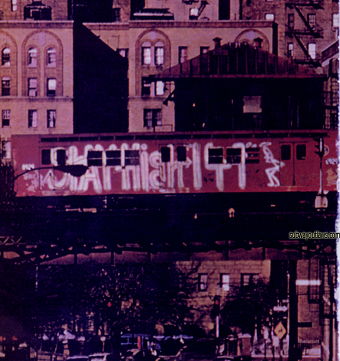
Even those that did not write Graffiti, noticed and respected the surface he claimed, for its uniqueness. He eventually made the transition from his signatures, like so many others, to colorful letters on the panels of subway cars. STAY HIGH was most famous for the top-to-
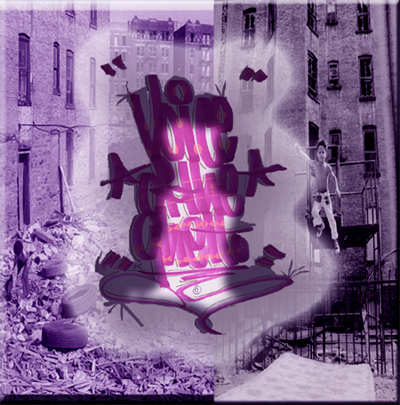
Copyright © Subwayoutlaws.com
bottom, of a stick figure subway car, seen in the book Faith of Graffiti. STAY HIGH then disappeared, staying out of sight for 27 years. In his absence many would claim to be him. Someone went as far as to tattoo STAY HIGH’s name on his arm and attending art shows claiming to be “STAY HIGH”. It wasn’t until TRACY 168 blew his cover, that the imposer was found. STAY HIGH’s disappearance became Graffiti’s unsolved mystery for many years, until he was found in early 2001. STAY HIGH was not only a writer, but also a symbol of the pop culture in New York City during the 1970’s
IllmaticDelta
Veteran

Skeme
Skeme, also known as 3 Yard King, is an American graffiti artist, known for All City, a group of graffiti pieces painted on many trains of the New York subway system.
Born in 1964 in Bronx, NYC, Skeme lived there for five years, before moving to Manhattan with his family. Surrounded by numerous graffiti pieces and murals as a teenager, Skeme began soaking the New York art in. He did his first graffiti in 1978. However, he painted his first train in 1980. Since then, the artist had begun “marking” the train lines one by one. This ultimately resulted in his pieces traveling through all five boroughs of New York City, or All City, as it became known. Only a handful of artists have managed to pull off this feat. One of the things Skeme is known for as well is bombing, a sort of interior writing where he employs his signature refined style – the style that has become one of the most significant in the world of graffiti art.
Skeme’s Subway Art

Skeme around 1982
For a short period of time, Skeme had made over a hundred different graffiti pieces. When only 16, the artist became known as “the king” of lines 1 and 3, as his pieces adorned the majority of trains on those two lines. At the same age, his works could go side by side with some of the most prominent graffiti giants of the time, such as Daze, Kool 131, Chain 3, and Phase 2, to name a few. He was also a part of many well-known groups like TMT (Ten Million Tags), INDS (Independents), 3YB and TDS.
Works on Paper by Skeme
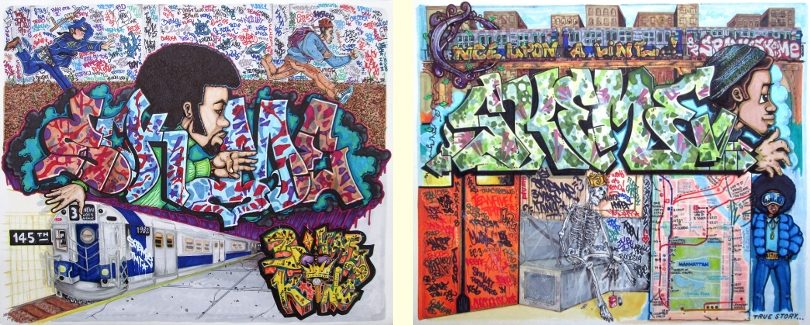
Skeme – Catch me if you Can, 2012 (left) / Skeme – Once Uopn A Line, 2014 (right)
Skeme came into prominence when he appeared in a documentary film titled Style Wars, a film about Hip Hop and Graffiti culture. In the movie, he talked about his beginnings, and the invitation he received from Phase 2 to paint a wagon (the wagon was subsequently titled Tuff City). Phase’s invitation turned out to be a pivotal moment in Skeme’s career. However, the artist’s mother wasn’t particularly fond of Skeme’s artistic endeavors, as she was afraid that he would succumb to the “bad influence” of New York. She pressured him to give up on graffiti and join the military when he was only 17. Skeme was enlisted in 1982, and for 28 years he served in various parts of the world. When he returned to the US in 2010, he was taken aback by the still popular and ever-developing graffiti art. He continued to produce his pieces, as he does to this day. Now, his paintings and graffiti are heavily influenced by Marvel Comics.
Pulp Fiction
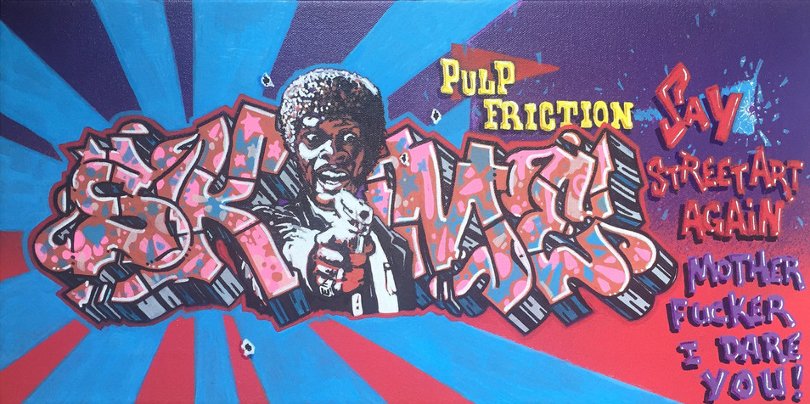
Skeme – Pulp Fiction, 2015
Cornbread's protege Topcat moved to Harlem and started tagging out there.
IllmaticDelta
Veteran
Cornbread's protege Topcat moved to Harlem and started tagging out there.
yup
GROUND WORK 1966-71
The history of the underground art movement known by many names, most commonly termed graffiti begins in Philadelphia, Pennsylvania during the mid to late '60s and is rooted in bombing. The writers who are credited with the first conscious bombing effort are CORNBREAD and COOL EARL. They wrote their names all over the city gaining attention from the community and local press. It is unclear whether this concept made its way to New York City via deliberate efforts or if was a spontaneous occurrence.
The competitive atmosphere led to the development of actual styles, which would depart from the tag styled pieces. Broadway style was introduced by Philadelphia's TOPCAT 126. These letters would evolve in to block letters, leaning letters, and blockbusters. PHASE 2 later developed Softie letters, more commonly referred to as Bubble letters. Bubble letters and Broadway style were the earliest forms of actual pieces and therefore the foundation of many styles. Soon arrows, curls, connections and twists adorned letters. These additions became increasing complex and would become the basis for Mechanical or Wild style lettering.
About New York City Graffiti @149st
IllmaticDelta
Veteran

Dondi
Dondi White, born Donald Joseph White in 1961, is one of the true street art legends of the original New York graffiti scene, often considered as one of the most influential graffiti writers in the scene. Dondi developed his unique and bold way of writing in the 1970’s, which saw him using the tags NACO and DONDI. 1977 saw him join the TOP crew (The Odd Partners) before starting his own crew in 1978, CIA (Crazy Inside Artists), which included names like Doc, Mare139, Kid56, Kel139 and Duro, while their friends Crash and Rasta joined in later as well. Dondi was quite unique in his approach to graffiti writing, often planning in great detail the pieces he was going to go and paint out in the street, practicing several times in sketch books before creating the final piece. Although Dondi was capable of producing the classic wildstyle form of graffiti writing, he preferred and developed his original large block style, which has remained influential to this day, allowing people to be able to read the text and also enabled Dondi to create patterns within the letters. 1980 saw Dondi become involved with the Esses Studio project, aimed at preserving subway art, during which he started to produce artworks on canvas, before becoming associated with the Soul Artists crew, formed by Marc André Edmonds aka ALI. The association with Soul Artists saw Dondi rubbing shoulders with graffiti creators such as Futura 2000, Keith Haring, Eric Haze, Lee Quiñones, Zephyr and Jean-Michel Basquiat. Later artworks saw Dondi moving away from street graffiti to produce collages and drawings. Unfortunately, Dondi White passed away from AIDS in New York, 1998, aged just 37. Catch up with our street art legends series by reading Street Art Legends: The Best of Basquiat Art and Street Art Legends: King Robbo Graffiti, about the work of King Robbo.
For more than 20 years in New York City, graffiti culture was as pervasive as it was secretive. Scores of underground artists worked in the shadows to create illicit and unconventional masterpieces-colorful and graphic paintings made with aerosol spray paint on New York City subway lines. Graffiti writer Dondi White came up in the 1970s, plastering his name and many aliases on dozens of subway trains. His work and personality stood out in the culture, and he became a star among graffiti writers. As New York’s Metropolitan Transit Authority (MTA) eradicated graffiti writing from its trains, White became one of many graffitists who began to work aboveground. Graffiti-based art was at the heart of New York’s art scene in the 1980s. White put his work on canvas and exhibited it in art galleries. He was the first graffiti artist to have a one-man show in the Netherlands and Germany, and his work is collected by European museums. After his death in 1998, White’s brother Michael, and graffiti writer Andrew “Zephyr” Witten, collaborated on the book Dondi White: Style Master General, The Life of Graffiti Artist Dondi White, Regan Books 2001.
K.O.N.Y
Superstar
Not sure if this was touched on yet
But who pioneered the more hip hop bubble letter WILDSTYLE form of graffiti art?
But who pioneered the more hip hop bubble letter WILDSTYLE form of graffiti art?
IllmaticDelta
Veteran
Not sure if this was touched on yet
But who pioneered the more hip hop bubble letter WILDSTYLE form of graffiti art?
phase 2
IllmaticDelta
Veteran
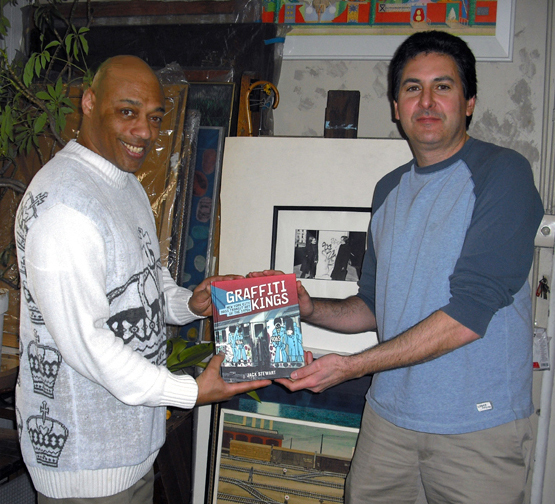

Blade

Blade – Icon of the New York City and a Hero-Figure
aprile 2, 2017 One Fat
Share this post !
Steven D. Ogburn, better known as Blade or Steve, a famed New York-based street artist and a proud owner of the title King of Graffiti since he painted over five thousand trains with his striking characters. Famous for his whole cars, he became an icon of the New York City and a hero-figure for the younger generation of street artists. Today he exhibits his work internationally.
Born on January 23rd, 1957, Blade began writing on the trains in NYC in 1972, when Hondo 1 took him to Baychester layup in the Bronx to paint his first train. At that time, he was only 15 years old. Subsequently, he befriended with such creatives as Fresco, Dr. Sex, Chino1, and Camaro 170 and became one of the most prolific street artists of his generation creating over five thousand pieces throughout the Big Apple in a decade between 1972 and 1982 one of the original members of The Crazy Five can be given the title of longest reigning whole car king of the 2s and 5s.In that time, there were no other graffiti influences, so he developed his own personal style composed of characters, letters, colors and abstract imagery. His images were not political but more personality focused. The trains were his diary and painted over 5,000 trains but is best remembered for his iconic whole-cars.

Blade embodies everything that is classically associated with graffiti: illegally painting trains, whilst avoiding cops, guard dogs, oncoming trains and the third rail.
Outside of the graffiti movement were two photographers who were suitably impressed with BLADE’s new works, their names were Marty Cooper and Henry Chalfant. Both photographers documented the BLADE paintings and in 1984, with the publication of their seminal work Subway Art, the works were seen around the world helping to launch a global graffiti movement continued their careers until 1984, before succumbing to the lure of the fine art world.





York’s ‘King of Graf’

Blade is a true graffiti pioneer, painting over 5,000 pieces on New York’s subway between 1972 and 1984. Blade embodies everything that is classically associated with graffiti: illegally painting trains, whilst avoiding cops, guard dogs, oncoming trains and the third rail. The prize was recognition within a subculture that wider society often hated, long before it became fashionable and graffiti made any transition into galleries. Blade is credited with developing several classic graffiti styles, was exhibited in key early gallery shows and has remained active in the contemporary art World since; his work was recently included in the ‘Art In The Streets’ show at MOCA in LA and the Brooklyn Museum in New York.
Check the Blade slideshow below…
Sharpening Blade
I started writing graffiti in early 1972 with Hondo1, Fresco, Dr. Sex and Camaro 170. My name ‘Blade’ comes from the fact that I always carried my box cutter to work and to gang fights. I was only 15 in 1972 so I always wrote Blade!
Because I was doing graffiti from the beginning there were no graffiti influences – we learned as we went along. I painted my first character in November 1974 (Easel Man & Snowman). Back then the security in train yards was not so tough. I started writing on mail trucks with Chino1 in 1972, then the buses, then the outside of trains. I did the insides of trains later.
I got my paint from hardware stores and I racked up all over the city [racking means stealing paint]. In the beginning we would make sketches in school; I sketched until 1980 but many times we we’d go out to paint I would freestyle. My style evolved because I dream in color! My mind has always drifted through space (which you can see in my work).

When I would paint whole cars I would do 750-1000 a year. I would just cut loose and go for it! When we painted the big danger was bring hit by a train or falling off of a layup [where trains park on the elevated tracks – police wouldn’t climb up there] from 50 feet down to the street and get run over by a car or truck. But for us it was the only way to have any self-expression.
We’d hit the same spots maybe three or four times in a row then the spot would get hot so we’d paint somewhere else. In 1974 I remember we paint the ‘money car,’ which carried money through NY. They said no one could paint a piece on it. We did! In 1978 Comet and I both painted double whole cars – that was epic! The culture was competitive but there was no beef – our beef was never with other writers, we were all working against the system. If someone painted something great you’d want to go out and do better but there was no beef; there was a real sense of unity.

The Government had a program that closed schools in 1972 and that had a lot to do with how graf started. My crew became TCF, or The Crazy 5, with Death, Vamm, Crachee, Tull and Comet. Our biggest fear was the Vietnam War. Vamm, Crachee, Death, Tull 13 and myself were listening to Nixon on the radio invading ‘Nam when I was 17 (in 1974). Back then the US had a draft so if they called you then you had to go and fight. I missed the Vietnam draft by 23 days. I was born on January 23,1957. If you’re born up to December 31st 1956 you got your draft card. Those were scary times.
The golden age of graffiti was 1970-1975 because that was the start in NYC! At the start there were no masterpieces, only single hits [bombs] and tags. Masterpieces developed in the summer of 1972; graffiti just got bigger and bigger and now it exists around the whole world.

I painted over 5,000 train cars with Comet. From 1972-1982 I painted all these trains and I never went to jail. Nobody believes it but you can find out anything on the internet! My name is Steven David Ogburn; I was born on the 23rd January 1957 and I only went to jail for one day for racking up paint in 1974! I was chased by the police all the time but I was just so fast - police were also older back in the day!
In terms of styles, I created overlapping 3D letters in 1975 and Blockbuster Letters in 1977. If you see the Subway Art book (Henry Chalfant & Martha Cooper), my best pieces are there, documented for all time!

In terms of painting today I would love to go to Italy! It’s my dream but no gallery has invited me yet. I stopped painting trains in 1984 because I was 30 and I had nothing left to prove. I was the King of NYC graffiti for 10 years and now the galleries want me in Europe.
My first show in Europe was 1981. It’s been great to show my stuff to people in Europe. They have shown me love for over 30 years! I made the cover of the Sotheby’s catalogue in Amsterdam in 2005 - I‘m the first living person to make the cover since Andy Warhol. I have travelled the world and been in the best museums (Whitney in NYC, Gronigen Museum in Amsterdam, Boymens’ Museum in Germany, MOCA in LA). It was an honor to go to China & paint with Zang Dali in 2010. At 55 I’m happy to be alive and looking forward to bigger & better things to come!

IllmaticDelta
Veteran
first gen hiphop, bboys

"The nikka Twins"
their influences


"The nikka Twins"
their influences


